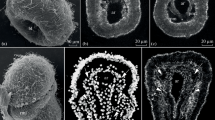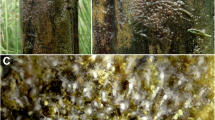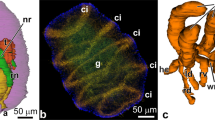Abstract
Mesoderm origin in Bryozoa is largely unknown. In this study, embryonic and early larval stages of Membranipora membranacea, a bryozoan exhibiting a planktotrophic cyphonautes larva, are investigated using mainly ultrastructural techniques. Shortly after the onset of gastrulation, an ectodermal cell, which is situated centrally at the prospective anterior pole of the larva, can be recognized by its constricted apical surface and enlarged basal part. It is also distinct from other ectodermal cells by the composition of its cytoplasm. In later stages, it has left the epidermis, lost its epithelial character, and is situated subepithelially, between the basal sides of the ectodermal and endodermal sheets. A blastocoelic cavity is not present at this stage. This cell divides and gives rise to a group of cells forming a muscular and neuronal strand at the anterior side of the larva. The majority of the larval musculature originates from this ingression. Despite this evidence for an ectodermal origin, additional sources of mesoderm can so far not be excluded. The literature on mesoderm origin in Bryozoa is reviewed and the results are compared to known data from other metazoan taxa.







Similar content being viewed by others
References
Ackermann C, Dorresteijn A, Fischer A (2005) Clonal domains in postlarval Platynereis dumerilii (Annelida : Polychaeta). J Morphol 266:258–280
Barrois J (1880) Mémoire sur la metamorphose des Bryozoaires. Ann Sci Nat Zool Ser 13(9):1–67 + 4pls
Bartolomaeus T (2001) Ultrastructure and formation of the body cavity lining in Phoronis muelleri (Phoronida, Lophophorata). Zoomorphology 120:135–148
Borg F (1927) Studies on recent cyclostomatous Bryozoa. Zool Bidr Uppsala 10:181–507
Boyer BC, Henry JQ (1998) Evolutionary modifications of the spiralian developmental program. Amer Zool 38:621–633
Boyer BC, Henry JJ, Martindale MQ (1996) Dual origins of mesoderm in a basal spiralian: cell lineage analyses in the polyclad turbellarian Hoploplana inquilina. Dev Biol 197:329–338
Boyer BC, Henry JJ, Martindale MQ (1998) The cell lineage of a polyclad turbellarian embryo reveals close similarity to coelomate spiralians. Dev Biol 204:111–123
Braem F (1890) Untersuchungen über die Bryozoen des süssen Wassers. Zoologica 2:1–134, pls. 1–15
Braem F (1897) Die geschlechtliche Entwicklung von Plumatella fungosa. Zoologica 10:1–96
Braem F (1908) Die geschlechtliche Entwicklung von Fredericella sultana. Zoologica 52:1–37
Brien P (1953) Études sur les Phylactolémates Evolution de la zoecie—Bourgeonnement d’accroissement Bourgeonnement statoblastique—Embryogenese—L’Ontogenese multiple. Ann Soc R Zool Belg 84:301–444
Burton PM (2008) Insights from diploblasts: the evolution of mesoderm and muscle. J Exp Zool 310B:5–14
Calvet L (1900) Contribution à l’histoire naturelle des bryozoaires ectoproctes marins. Trav Inst Zool Univ Montpellier 8:1–488
Cook PL (1962) The early larval development of Membranipora seurati (Canu) and Electra crustulenta (Pallas), Polyzoa. Cah Biol Mar 3:57–60
Corrêa DD (1948) A embryologia de Bugula flabellata (J. V. Thompson) (Bryozoa Ectoprocta). Zoologia, Sao Paulo 13:7–71
d’Hondt JL (1983) Sur l’évolution des quatre macroméres du pôle végétatif chez les embryons de Bryozoaires Eurystomes. Cah Biol Mar 24:177–185
d’Hondt JL (2005) État des connaissances sur le développement embryonaire des Bryozoaires Phylactolaemates. Denisia 16:59–68
Davenport CB (1891) Observations on budding in Paludicella and some other Bryozoa. Bull Mus Comp Zool 22:1–114
Davidson EH, Cameron RA, Ransick A (1998) Specification of cell fate in the sea urchin embryo: summary and some proposed mechanisms. Development 125:3269–3290
de Selys-Longchamps M (1907) Phoronis. Fauna Flora Golf Neapel 30:1–280
Dilly PN (1973) The larva of Rhabdopleura compacta (Hemichordata). Mar Biol 18:69–86
Dudley JE (1973) Observations on the reproduction, early larval development, and colony astogeny of Conopeum tenuissimum (Canu). Chesap Sci 14:270–278
Dunn CW, Hejnol A, Matus DQ, Pang K, Browne WE, Smith SA, Seaver E, Rouse GW, Obst M, Edgecombe GD, Sorensen MV, Haddock SHD, Schmidt-Rhaesa A, Okusu A, Kristensen RM, Wheeler WC, Martindale MQ, Giribet G (2008) Broad phylogenomic sampling improves resolution of the animal tree of life. Nature 452:745–749
Freeman G (1993) Regional specification during embryogenesis in the articulate brachiopod Terebratalia. Dev Biol 160:196–218
Freeman G (1995) Regional specification during embryogenesis in the inarticulate brachiopod Glottidia. Dev Biol 172:15–36
Freeman G (1999) Regional specification during embryogenesis in the inarticulate brachiopod Discinisca. Dev Biol 209:321–339
Freeman G (2000) Regional specification during embryogenesis in the inarticulate brachiopod Crania anomala. Dev Biol 227:219–238
Freeman G (2003) Regional specification during embryogenesis in rhynchonelliform brachiopods. Dev Biol 261:268–287
Freeman G, Martindale MQ (2002) The origin of mesoderm in phoronids. Dev Biol 252:301–311
Fuchs J, Obst M, Sundberg P (2009) The first comprehensive molecular phylogeny of Bryozoa (Ectoprocta) based on combined analyses of nuclear and mitochondrial genes. Mol Phylogenet Evol 52:225–233
Grobe P (2008) Larval development, the origin of the coelom and the phylogenetic relationships of the Phoronida. Dissertation, Freie Universität Berlin, Germany
Gruhl A (2008) Muscular systems in gymnolaemate bryozoan larvae (Bryozoa: Gymnolaemata). Zoomorphology 127:143–159
Halanych KM (2004) The new view of animal phylogeny. Ann Rev Ecol Syst 35:229–256
Harmer SF (1893) On the occurrence of embryonic fission in cyclostomatous Polyzoa. Q J Microsc Sci N S 34:199–241
Harmer SF (1898) On the development of Tubulipora, and some British and northern species of this genus. Q J Microsc Sci N S 41:73–157
Hejnol A, Martindale MQ, Henry JQ (2007) High-resolution fate map of the snail Crepidula fornicata: the origins of ciliary bands, nervous system, and muscular elements. Dev Biol 305:63–76
Helmkampf M, Bruchhaus I, Hausdorf B (2008) Multigene analysis of lophophorate and chaetognath phylogenetic relationships. Mol Phylogenet Evol 46:206–214
Henry JJ, Martindale MQ (1998) Conservation of the spiralian developmental program: cell lineage of the nemertean, Cerebratulus lacteus. Dev Biol 201:253–269
Henry JJ, Martindale MQ (1999) Conservation and innovation in spiralian development. Hydrobiologia 402:255–265
Henry JQ, Tagawa K, Martindale MQ (2001) Deuterostome evolution: early development in the enteropneust hemichordate, Ptychodera flava. Evol Dev 3:375–390
Herrmann K (1980) Die archimere Gliederung bei Phoronis muelleri (Tentaculata). Zool Jb Anat Ontog Tiere 103:234–249
Herrmann K (1986) Die Ontogenese von Phoronis mülleri (Tentaculata) unter besonderer Berücksichtigung der Mesodermdifferenzierung und Phylogenese des Coeloms. Zool Jb Anat Ontog Tiere 114:441–463
Jang K, Hwang U (2009) Complete mitochondrial genome of Bugula neritina (Bryozoa, Gymnolaemata, Cheilostomata): phylogenetic position of Bryozoa and phylogeny of lophophorates within the Lophotrochozoa. BMC Genomics 10:167
Kraepelin K (1892) Die Deutschen Süsswasser-Bryozoen. Eine Monographie. II. Entwickelungsgeschichtlicher Teil. Abh Naturwiss Verein Hamburg 12:1–67, pls. 1–5
Lambert JD (2008) Mesoderm in spiralians: the organizer and the 4d cell. J Exp Zoolog B Mol Dev Evol 310:15–23
Long JA, Stricker SA (1991) Brachiopoda. In: Giese AC, Pearse JS, Pearse VB (eds) Reproduction of marine invertebrates VI. Echinoderms and lophophorates. Boxwood Press, Pacific Groove, pp 47–84
Lüter C (2000) The origin of the coelom in Brachiopoda and its phylogenetic significance. Zoomorphology 120:15–28
Marcus E (1926) Beobachtungen und Versuche an lebenden Meeresbryozoen. Zool Jb 52:1–102
Marcus E (1934) Über Lophopus cristallinus (Pall.). Zool Jb Anat Ontog Tiere 58:501–606
Mawatari S, Mawatari SF (1975) Development and metamorphosis of the cyphonautes of Membranipora serrilamella Osburn. In: Pouyet S (ed) Bryozoa 1974. Université Claude Bernard, Lyon, pp 13–18, 2pl
Morgan TH (1891) The growth and metamorphosis of tornaria. J Morphol 5:407–458
Nielsen C (1970) On metamorphosis and ancestrula formation in cylostomatous bryzoans. Ophelia 7:217–256
Nielsen C (1971) Entoproct life-cycles and the entoproct/ectoproct relationship. Ophelia 9:209–341
Nielsen C (1990) Bryozoa Ectoprocta. In: Adiyodi KG, Adiyodi RG (eds) Reproductive biology of invertebrates vol IV, Part B, Fertilization, development and parental care. Wiley, London, pp 185–200
Nielsen C (1991) The development of the brachiopod Crania (Neocrania) anomala. Acta Zool 27:7–28
Nielsen C (2001) Animal evolution. Interrelationships of the living phyla. Oxford University Press, Oxford
Nielsen C (2004) Trochophora larvae: Cell-lineages, ciliary bands, and body regions. 1. Annelida and Mollusca. J Exp Zool B 302:35–68
Nielsen C (2005) Trochophora larvae: Cell-lineages, ciliary bands, and body regions. 2. Other groups and general discussion. J Exp Zool B 304:401–447
Ostrovsky AN (2008a) External versus internal and self- versus cross-fertilization in Bryozoa: transformation of the view and evolutionary considerations. In: Wyse Jackson PN, Spencer Jones ME (eds) Annals of bryozoology 2. International Bryozoology Association/Trinity College, Dublin, pp 103–115
Ostrovsky AN (2008b) The parental care in cheilostome bryozoans: a historical review. In: Wyse Jackson PN, Spencer Jones ME (eds) Annals of bryozoology 2. International Bryozoology Association/Trinity College, Dublin, pp 211–245
Ostrovsky AN, Vavra N, Porter JS (2008) Sexual reproduction in gymnolaemate Bryozoans: history and perspectives of the research. In: Wyse Jackson PN, Spencer Jones ME (eds) Annals of bryozoology 2. International Bryozoology Association/Trinity College, Dublin, pp 117–210
Pace RM (1906) On the early stages in the development of Flustrella hispida (Fabricius), and on the existence of a “yolk nucleus” in the egg of this form. Q J Microsc Sci 50:435–478 + 4 pls
Passamaneck YJ, Halanych KM (2004) Evidence from Hox genes that bryozoans are lophotrochozoans. Evol Dev 6:275–281
Passamaneck YJ, Halanych KM (2006) Lophotrochozoan phylogeny assessed with LSU and SSU data: evidence of lophophorate polyphyly. Mol Phylogenet Evol 40:20–28
Prouho H (1892) Contribution a l’histoire des bryozoaires. Arch Zool Exp Gén 10(2.Ser.):557–656
Reed CG (1987) Phylum Bryozoa. In: Strathmann MF (ed) Reproduction and development of marine invertebrates of the Northern Pacific coast. University of Washington Press, Seattle, pp 494–511
Reed CG (1991) Bryozoa. In: Giese AC, Pearse JS, Pearse VB (eds) Reproduction of marine invertebrates VI. Echinoderms and lophophorates. Boxwood Press, Pacific Groove, pp 85–245
Reed CG, Cloney RA (1982) The larval morphology of the marine bryozoan Bowerbankia gracilis (Ctenostomata: Vesicularioidea). Zoomorphology 100:23–54
Reed CG, Woollacott RM (1982) Mechanisms of rapid morphogenetic movements in the metamorphosis of the bryozoan Bugula neritina (Cheilostomata, Cellularioidea) I. Attachment to the substratum. J Morphol 172:335–348
Rieger MR, Ladurner P (2003) The significance of muscle cells for the origin of mesoderm in Bilateria. Integ Comp Biol 43:47–54
Robertson A (1903) Embryology and embryonic fission in the genus Crisia. Univ Calif Publ Zool 1:115–156
Ruppert EE, Balser EJ (1986) Nephridia in the larvae of hemichordates and echinoderms. Biol Bull 171:188–196
Santagata S (2004) Larval development of Phoronis pallida (Phoronida): implications for morphological convergence and divergence among larval body plans. J Morphol 259:347–358
Shook D, Keller R (2003) Mechanisms, mechanics and function of epithelial-mesenchymal transitions in early development. Mech Dev 120:1351–1383
Silén L (1966) On the fertilization problem in the gymnolaematous Bryozoa. Ophelia 3:113–140
Stricker SA, Reed CG, Zimmer RL (1988) The cyphonautes larva of the marine bryozoan Membranipora membranacea. I. General morphology, body wall, and gut. Can J Zool 66:368–383
Ström R (1969) Sexual reproduction in a stoloniferous bryozoan, Triticella koreni (G.O. Sars). Zool Bidr Uppsala 38:113–127
Ström R (1977) Brooding patterns of bryozoans. In: Woollacott RM, Zimmer RL (eds) Biology of bryozoans. Academic Press, New York, pp 23–55
Sun M, Wu Z, Shen X, Ren J, Liu X, Liu H, Liu B (2009) The complete mitochondrial genome of Watersipora subtorquata (Bryozoa, Gymnolaemata, Ctenostomata) with phylogenetic consideration of Bryozoa. Gene 439:17–24
Tagawa K, Nishino A, Humphreys T, Satoh N (1998) The spawning and early development of the hawaiian acorn worm (hemichordate), Ptychodera flava. Zool Sci 15:85–91
Technau U, Scholz CB (2003) Origin and evolution of endoderm and mesoderm. Int J Dev Biol 47:531–539
Temkin MH (1996) Comparative fertilization biology of gymnolaemate bryozoans. Mar Biol 127:329–339
Vigelius WJ (1886) Zur Ontogenie der marinen Bryozoen. Mitt Zool Stn Neapel 6:499–541
Waeschenbach A, Telford MJ, Porter JS, Littlewood DTJ (2006) The complete mitochondrial genome of Flustrellidra hispida and the phylogenetic position of Bryozoa among the Metazoa. Mol Phylogenet Evol 40:195–207
Wood TS (2008) Development and metamorphosis of cyphonautes larvae in the freshwater ctenostome bryozoan, Hislopia malayensis Annandale, 1916. In: Hageman GS, Key MM Jr, Winston JE (eds) Bryozoan studies 2007. Virginia Museum of Natural History, Martinsville
Woollacott RM, Zimmer RL (1971) Attachment and metamorphosis of the cheilo-ctenostome bryozoan Bugula neritina (Linné). J Morphol 134:351–382
Wray GA (1997) Echinoderms. In: Gilbert SF, Raunio AM (eds) Embryology: constructing the organism. Sinauer Associates, Sunderland, pp 309–329
Zimmer RL (1980) Mesoderm proliferation and formation of the protocoel and metacoel in early embryos of Phoronis vancouverensis. Zool Jb Anat Ontog Tiere 103:219–233
Zimmer RL (1997) Phoronids, brachiopods, and bryozoans, the lophophorates. In: Gilbert SF, Raunio AM (eds) Embryology: constructing the organism. Sinauer Associates, Sunderland, pp 279–305
Zimmer RL, Woollacott RM (1977) Structure and classification of gymnolaemate larvae. In: Woollacott RM, Zimmer RL (eds) Biology of bryozoans. Academic Press, New York, pp 57–89
Zimmer RL, Woollacott RM (1989) Larval morphology of the bryozoan Watersipora arcuata (Cheilostomata: Ascophora). J Morphol 199:125–150
Zimmer RL, Woollacott RM (1993) Anatomy of the larva of Amathia vidovici (Bryozoa: Ctenostomata) and phylogenetic significance of vesiculariform larva. J Morphol 215:1–29
Zimmer RL (1964) Reproductive biology and development of Phoronida. Dissertation, University of Washington
Acknowledgments
I thank Thomas Bartolomaeus (Bonn) for helpful comments and discussions on the manuscript. Many thanks go to Dennis Willows for providing facilities at Friday Harbour Laboratories (Washington, USA) and especially to Richard Strathmann for advice on rearing of Membranipora embryos. I also thank three anonymous reviewers for their valuable remarks.
Author information
Authors and Affiliations
Corresponding author
Rights and permissions
About this article
Cite this article
Gruhl, A. Ultrastructure of mesoderm formation and development in Membranipora membranacea (Bryozoa: Gymnolaemata). Zoomorphology 129, 45–60 (2010). https://doi.org/10.1007/s00435-009-0099-3
Received:
Revised:
Accepted:
Published:
Issue Date:
DOI: https://doi.org/10.1007/s00435-009-0099-3




